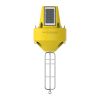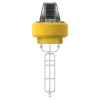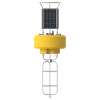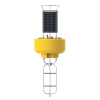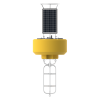NexSens CB-250 Data Buoy
Features
- Integrated 15-watt solar panels for 45-watts of solar charging
- Three 2" diameter sensor holes with female NPT threads for sensor deployment
- Topside plate supports solar marine light, weather stations, and other sensors
- Expedited repair and warranty service
- Lifetime technical support
- More
The NexSens CB-250 Data Buoy is designed for deployment in lakes, rivers, coastal waters, harbors, estuaries and other freshwater or marine environments. The floating platform supports both topside and subsurface environmental monitoring sensors including weather stations, wave sensors, thermistor strings, multi-parameter sondes, Doppler current profilers and other monitoring instruments.
The buoy is constructed of an inner core of cross-linked polyethylene foam with a tough polyurea skin. A topside 20” tall stainless steel tower includes three 15-watt 12VDC semi-flexible solar panels, and a center 10” ID x 19.5” tall instrument well accommodates batteries, data loggers, sensors, and more. Three 2” pass-through holes with female NPT bottom threads allow for quick connection of instrument deployment pipes and custom sensor mounts. The stainless steel frame supports both single point and multi-point moorings.
The CB-250 Data Buoy is optimized for use with NexSens X3 data loggers. Wireless telemetry options include global 4G LTE cellular, Iridium satellite, and global 4G LTE cellular with Iridium satellite fallback. Compatible digital sensor interfaces include RS-232, RS-485 and SDI-12. Each sensor port offers a UW receptacle connector with double O-ring seal for a reliable waterproof connection. For custom integrations, CB-PTL pass through and CB-MCL wet-mate data well lids are available.
- Hull Outer Diameter: 30.0” (76.2cm)
- Hull Height: 20.0” (50.8cm)
- Data Well Inner Diameter: 10.3” (26.2cm)
- Data Well Height: 19.5" (49.5cm)
- Pass-Through Hole Diameter: 2.0" (5.1cm)
- Tower Height: 20.0” (50.80cm)
- Solar Panels: 3x 15-watts
- Weight: 115 lb (52kg)
- Net Buoyancy: 250 lb (114kg)
- Hull Material: Cross-linked polyethylene foam with polyurea coating & stainless steel deck
- Hardware Material: 316 stainless steel
- Mooring Attachments: 3x 3/4” eyenuts
- (1) CB-250 solar tower
- (1) CB-250 buoy hull
- (1) CAGE instrument cage
In The News
Sustainable Fishing in Alaska: Protecting the Salmon Capital of the World through Research
In the far north, the Alaska Peninsula stretches away from the Last Frontier into the Pacific Ocean. A narrow strip of land dotted with freshwater lakes and intruded upon by ocean inlets–this unique region is intimately connected with the surrounding water. Nestled halfway down the peninsula's southern coast are the small villages of Chignik. The area has historically been home to the Aleut people and has been heavily reliant on fishing for centuries. Home to commercial and subsistence fishing today, Chignik continues to rely upon the salmon returns to the surrounding villages, which are supported by scientists working tirelessly to understand and steward these fish populations.
Read MoreNexSens X3 Data Logger Review
Extreme environments meet extreme design with the NexSens X3 Data Logger . The new logger offers the latest in real-time monitoring technology with wireless communication, a large plug-and-play sensor library and ultra-low power consumption, all in a waterproof marine-grade housing. The X3 is built to handle harsh weather, floods, high winds and rough seas, and it stands alone; no additional protective housing needed. With an operating temperature that ranges from -40°C to 70°C, the logger can withstand arctic environments and extreme heat. A conformal coating on the internal circuit board isolates it from moisture and humidity.
Read MoreBuoy-Based Solutions: Strengthening Kentucky’s Emergency Response Efforts
When Kentucky’s Emergency Response Team (ERT) has to act quickly in response to chemical and oil spills in the Commonwealth, they rely on small, easily deployable buoys to collect critical data that help minimize and evaluate damages in environmental emergencies. With a background in geology, Robert Blair primarily worked with groundwater and got involved sporadically with the ERT during groundwater contamination emergencies. Over time, this involvement led to him joining the ERT as an On-Scene Coordinator and then becoming the branch manager for the team and overall Emergency Response Branch .
Read More



































